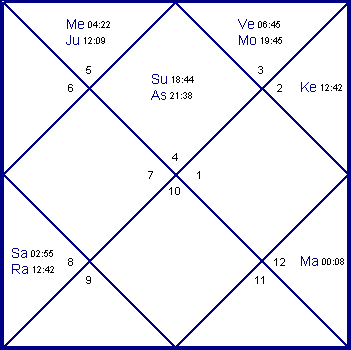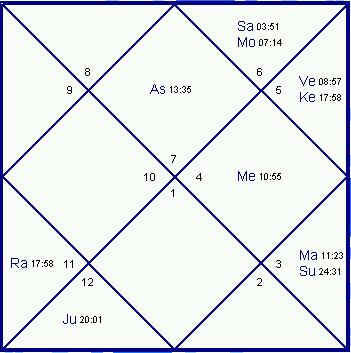The Reflective Factor of The Nodes
By Dean Dominic De Lucia
In the 34th chapter of Brihat Parasara Hora Sastra, 16th verse, the Maharishi Parasara describes the basic effects of Rahu and Ketu. There the Rishi states that
Rahu and Ketu give predominantly the effects as due to their conjunction with a house lord or as due to the house they
occupy.
This is because they are Chaya Grahas, shadowy planets. By definition, a shadow reflects the reality of another, although it is not a perfect duplication. And a shadow still has its own existence, even though it mimics
another.
This reflective nature of the nodes, besides being outlined by Parasara, is corroborated in the puranic histories. As the narration goes, the demigods retired to the assembly hall of Indra to partake of the nectar of immortality. This was done after churning the mountain Mandara wherefrom the nectar
came.
At that time, the Daitya Rahu disguised himself as one of the demigods and had a sip of the nectar. He was discovered by the sun and the moon who reported this to Vishnu. And Vishnu, of course, severed his head by which act the axis was
born.
What we are interested in is the fact that, being in the assembly hall of the gods, Rahu became like one of them. In other words he reflected his surroundings. In predictive astrology also, Rahu reflects the influence of his sign lord, his planetary association and any aspects that he may
receive.
But he also has his own results to give independent of his reflective nature. This is all in keeping with the above-cited verse of Parasara Maharishi because the Muni simply states that Rahu has a
" predominently," or mostly reflective nature. The Rishi does not state that Rahu is an absolute chameleon or a transparent
medium.
The conundrum has to do with how much of which. In other words, various causative factors complicate interpretation. The question becomes, which is the most causative
?
It is the basic premise of this essay that Rahu will primarily give the results of his sign lord as long as these do not contradict his basic indications in terms of house position and the nature of his placement in a sign. After that, planetary associations and aspects may be reflected.
Chart A: Born August 4, 1956 at 6:31 DT in Washington, D.C.

Chart A illustrates a very important point, too; that Rahu will give the results of his sign
lord in preference to the results of planetary associations or aspects. As soon as the Saturn Dasa began, the
education of this native was interrupted prematurely. This only makes sense because Saturn as a planet of darkness and a bad lord
aspects the Vidyakaraka and Jnanakaraka, Jupiter and Mercury, respectively.
However, in the Mars Bhukti of Saturn, the native went back to school as a full-time college student. This is understandable because Yogakaraka Mars aspects the lord of the 4th and the 4th itself. What is even more interesting is the fact that the native spent the entire Rahu Bhukti in a business school with elite accreditation while maintaining a very high grade point
average!
Rahu associates with Saturn, and were he to simply mimic Saturn's results, he would have stopped education as Saturn did in his Dasa and Bhukti. But instead of giving the results of Saturn, Rahu flat out-and-out reflected the results of this sign lord Mars. The two results are contradictory, and the fact that a high level of educational achievement was maintained proves that Rahu favored the results of his sign-lord over the results of the planet with
which he associated. Remember that these results were reflected by Rahu even during the Saturn Dasa, Saturn being poison for education in this chart.
This chart also shows that Rahu will give his own results even if they are contradictory to those of his sign lord. Rahu brought about divorce and a long-distance relation, practically speaking separation, from this man's son. Debilitated Rahu in the 5th indicates this while Mars as the 5th lord in the 9th does not. In fact, during the Mars Bhukti the two were close. This shows that Rahu favoured his sign lord in terms of results.
Chart B: Born 10-7-1951
 Chart B shows us that Rahu will reflect the indications of his sign-lord in preference to those of any aspects he receives. All throughout the Rahu Dasa the native of this chart lived as a brahmachari monk. He abstained from the association of women and truly exhibited a renunciation mood. This is because Saturn
associates with the Moon in a pious sign in the house of renunciation. Rahu reflected all this being placed in Aquarius, a Saturnian sign.
Chart B shows us that Rahu will reflect the indications of his sign-lord in preference to those of any aspects he receives. All throughout the Rahu Dasa the native of this chart lived as a brahmachari monk. He abstained from the association of women and truly exhibited a renunciation mood. This is because Saturn
associates with the Moon in a pious sign in the house of renunciation. Rahu reflected all this being placed in Aquarius, a Saturnian sign.
Had Rahu given preference to the aspect of Venus, however, this would not have been so. Notice that Venus occupies the best Upachaya and that the sign lord of Venus occupies Gemini, a sign representing sexual union. The fact that Rahu gave renunciation proves that his sign lord is more influential than aspects.
Jupiter sits in the seventh
house in his own sign, and by the end of the major period, he had cemented a
conjugal relationship, i.e., against his celibate vows.
Saturn in the twelfth should
work to gradually disintegrate the relationship during the Saturn-major period,
or by the end of it, as Saturn gives his results slowly, and the bulk towards
the end of his period.
Chart C, of John Lennon : Born 9-10-1940 at 7 a.m. (DST) at 53* North, 03*
West. 
Lastly, it is interesting to note the chart of John Lennon (Chart C) vis-a-vis Bhavarta Ratnakara. In the section dealing with Virgo Ascendant, Ramanuja states that "if the Sun is related to the Moon or Venus
... there will be access to wealth in the course of the Sun's Dasa".
DR. RAMAN further elucidates by saying "As the Sun happens to be the lord of the 12th for Virgo he cannot give independent results" and that "Venus probably becomes deprived of the
good result he would have produced... if he were not connected with the Sun".
This seems to be the case because the 12th lord Sun, during Lennon's Rahu-Sun
sub period, gave him tremendous success in the form of a Number-One hit song (Saturday Night) with Elton John. Such results do not correspond to the 12th lord in and of
himself. It seems to be that Rahu, as a chaya graha, readily ascribed himself to the dictum of Bhavarta Ratnakara by surrendering the Raja Yoga results of his Bhukti to the Sun thereby exhibiting depleted strength in the Bhukti itself.
However, this logic does not have an absolute lock on things as it may be argued that the Raja Yoga was actually indicated by the Vipreeta situation in the 8th house. After all, it was actually in the Jupiter Bhukti that fame became manifest. So it may be said that Raja Yoga was not indicated until the Jupiter Bhukti came
about. But that still would not explain the Raja Yoga results of the 12th lord Sun. Therefore, I favor the idea that the chaya graha Rahu surrendered his results to Sun thereby depleting himself.
So thanks to the Sastra in the form of Brihat Parasara Hora and Bhavarta Ratnakara as well as to the practical example of several horoscopes, we can safely have faith in our basic premise; that Rahu and Ketu will favor the results of their sign-lords over the results indicated by conjunction or aspect, and that, at the same time, they have their own results to give in terms of house position and the nature of the sign they occupy.
This article first appeared in the September, 1994 issue of: The
Astrological Magazine
Astro
Books by Dharmapad!

Feel
Free to e-Mail Dharmapad

 Chart B shows us that Rahu will reflect the indications of his sign-lord in preference to those of any aspects he receives. All throughout the Rahu Dasa the native of this chart lived as a brahmachari monk. He abstained from the association of women and truly exhibited a renunciation mood. This is because Saturn
associates with the Moon in a pious sign in the house of renunciation. Rahu reflected all this being placed in Aquarius, a Saturnian sign.
Chart B shows us that Rahu will reflect the indications of his sign-lord in preference to those of any aspects he receives. All throughout the Rahu Dasa the native of this chart lived as a brahmachari monk. He abstained from the association of women and truly exhibited a renunciation mood. This is because Saturn
associates with the Moon in a pious sign in the house of renunciation. Rahu reflected all this being placed in Aquarius, a Saturnian sign.
